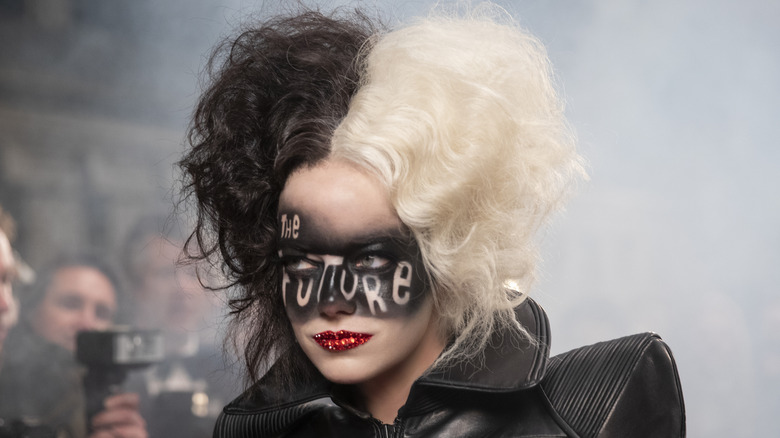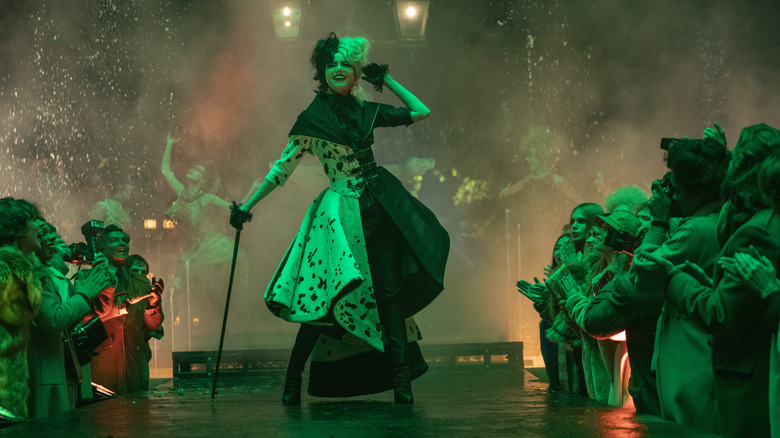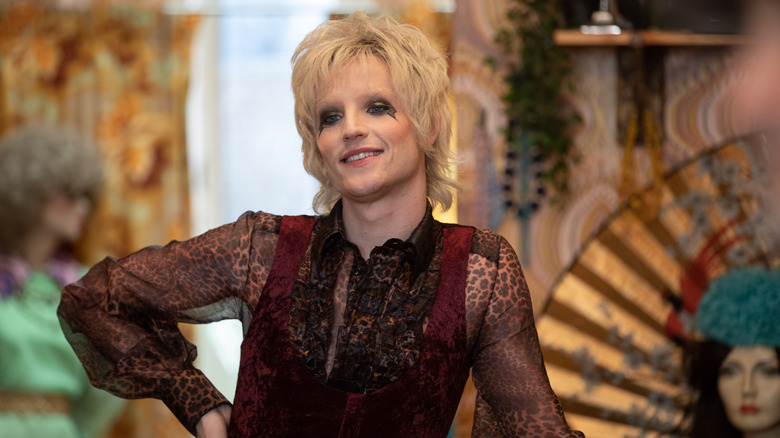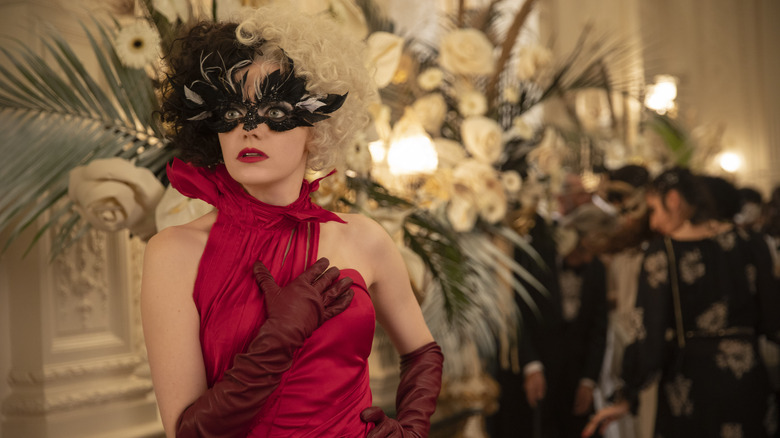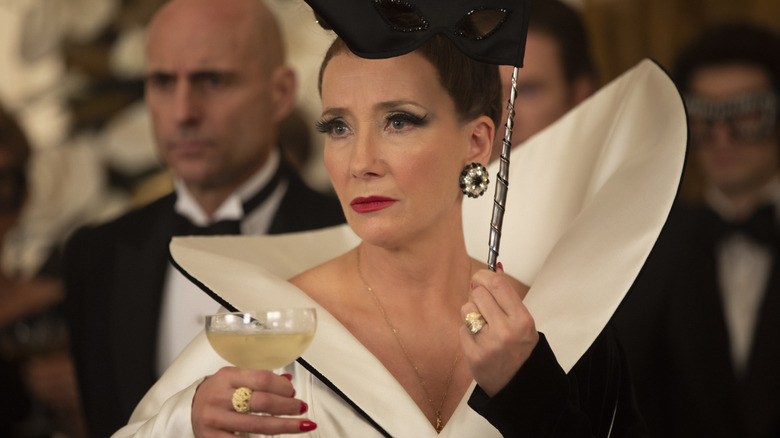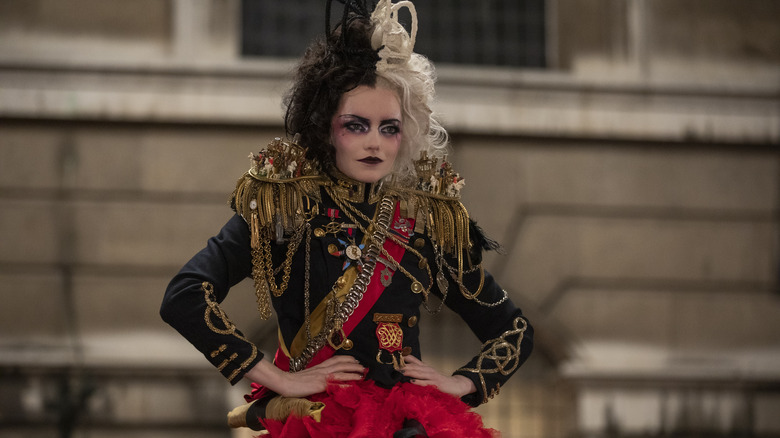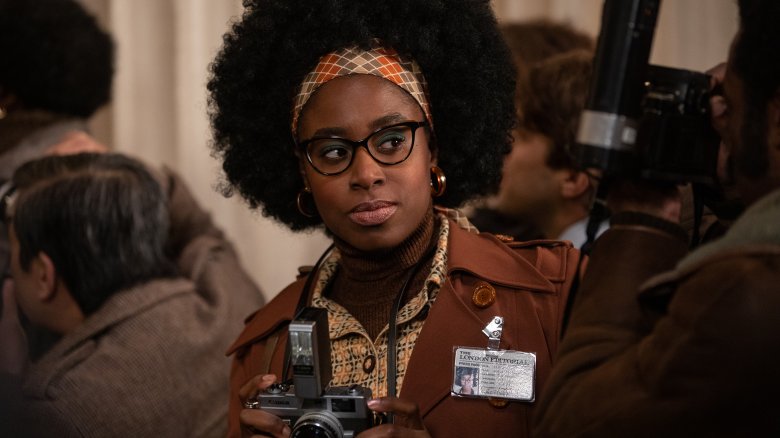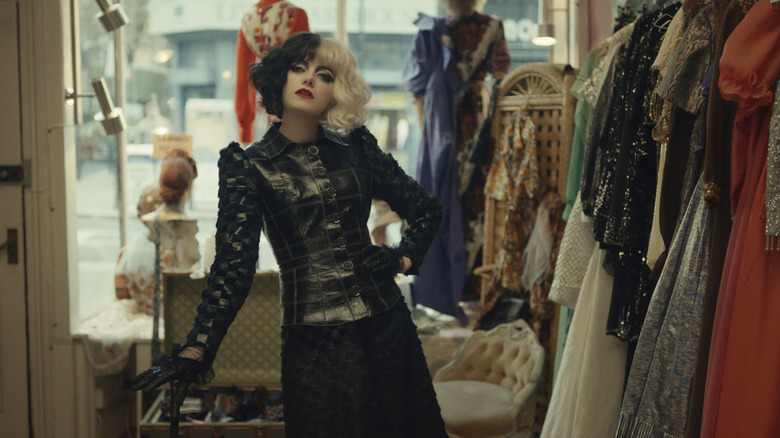Cruella Costume Designer Jenny Beavan On Revisiting The '70s London Fashion Scene [Interview]
Walt Disney Pictures' "Cruella" gave one of Disney's most hated villains from "101 Dalmations" a more sympathetic backstory and set the tone for her future. Set in the London fashion scene in the 1970s, Estella aka Cruella (Emma Stone) loses everything, finds a path in the revolutionary fashion world, and takes down the terrible Baroness (Emma Thompson) with talent, ruthlessness, cleverness, and some incredible clothing designs.
Those designs and the mind-blowing costumes come to us from Academy Award-winning costume designer Jenny Beavan. You absolutely know her work; she's designed costumes for films like "Mad Max: Fury Road," "A Room with a View," "The King's Speech," "Sherlock Holmes," "Sense and Sensibility," and so many more.
I spoke to Beavan about the wild designs of "Cruella," the '70s London fashion scene, the character of Artie (John McCrea), Emma Stone's flaming dress, and more. "Cruella" is currently streaming on Disney+.
"It was so funny, just being back in that world."
It's an honor to speak with you. Thank you for your work. I'd love to hear your thoughts about 1970s London fashion and what it was like delving back into that.
Well, as I'm sure you've read somewhere, I was very much around in the '70s. And it was sort of when I was just ... I'd left college, and was starting my career as a theater designer, and had not a lot of money, but a bit, so I was interested. It was never my big thing, fashion. But we had a wonderful shop called Crocodile, which I used to love in Kensington High Street. There was all sorts of Barbara Hulanicki ... I can't remember all the names, because it is rather a long time ago. But [the store] Biba was very big in my world, and also that thing of juxtaposing clothes. So we'd go to Portobello Market and buy a guard's jacket for three pounds. Proper military red coat, and put it with jeans, or put it with a skirt, often made out of Liberty fabrics.
I used to sew them in sort of tiers. They got bigger and bigger, and then wear them with big lace-up boots like, not Doc Martens, they were called Olafsdottirs. It was a Swedish-make, but they were the same sort of heavy lace-up I just loved, because I had rather large legs, so lace-up boot. I could do it up. And it was fabulous going back into that era. And sometimes when I saw the crowds, particularly when outside Liberty's on our first day of shooting, it was like, "Oh, my God." I mean, there's my past in front of me. And I used to go to Liberty's in the '70s. And it was so funny, just being back in that world.
Were there any specific people, fashion icons that you looked to influence specific characters?
Yes and no. I mean, obviously, Vivienne Westwood was very much around, and I've always quite liked her. I love her work, and her aesthetic, and her activism. But I think it was more a general feel about the '70s rather than specifics. Yes, we looked across the board. I mean, I probably looked at more fashion plates and more magazines from the period and found out some old photographs of my past.
There was a wonderful, I think, she was a German singer called Nina Hagen who seemed to embody the young Estella, not the child, but when she became sort of living in that squat as we called them in the '70s. Many of my friends and relations lived in squats. I never had to, but there were incredible stories of people living in derelict houses, and actually getting all the electricity work again, and having a marvelous time in really what you called Crown properties owned by the Queen, but actually left empty. So all that totally rang true to me, them living in that sort of the den, the attic.
"Give you an actor like John McCrea, and you're made."
I love the character of Artie so much. I'd love to hear your thoughts on dressing Artie.
Well, you give you an actor like John McCrea, and you're made. Aren't you? And of course, I'd seen him in the stage show, "Everybody's Talking About Jamie." And I guess what we were looking at with him was that totally over-the-top. The way it's written, you obviously got to go over the top. But it also was very much pop stars. Now, I can't truly remember which one really gave me ideas on him, but there was a lot of that sort of matching trousers and might what you call a vest and I call a waistcoat, and then with a puff sleeve, and the big sleeve. That was so '70s.
So he just sort of fell into place in a way. And I wanted him to be, obviously, have enormous charisma, and glamor, and fun, but not necessarily be overtly feminine. Because still in those days, I think it was still a cultural offense, that whole thing of homosexuality and the law changing around about the time that "Maurice" ... I did a film called "Maurice." And we were only allowed to make that film probably in the late '70s because the law had changed.
I'm sure everyone is asking you about the flaming dress because it is really spectacular. But can you talk a little bit about the design for that? How much was CGI, what the actual mechanics were?
Well, I'm really pleased that people are always asked if it was CGI because it proves that it's so well done by the visual effects. No, it was a visual effect. We made a cloak. We made the cloak, we made the dress. We never burnt the cloak. But I worked like you could do it. There's stuff called fire wire, and you could put it into it, and you can literally set fire to it, and you could have achieved something like that effect because I do like to make sure that things are possible. Because I think if an audience believes it, then they don't worry about it. It could've had happened.
So that dress and the dress underneath is made from the red dress in the window of Artie's shop. And so, I just really wanted to make sure there was enough fabric, A, in that dress. And so it had a big stole that you could wrap around. So there's a lot of extra fabric. I do not think you see it very clearly, but whatever, it's there. And then Ian Wallace [chief costume cutter], he'd always wanted to make a Charles James Tree Dress, off he went. In a way, if you deconstruct something, you've got a chance that it might just be in our fabric to do it with.
"It was such fun."
You have the animated movie to draw from here. And we're talking about an anti-hero, or in that version, the villain. How did the animated look affect your designs?
I would say pretty much not at all. I did have a quick look at it. I had a quick look at the Anthony Powell [costume designer] and Glenn Close, the first one, but then put them out of my mind, because in a way it's a totally different story. We're the story that leads up to it ... that where we end up the last images of Cruella could possibly become Glenn Close in the '90s. But we were still in the '70s, and it was a bit tenuous, I would say, that link.
So the Baroness, those dresses. I'm not going to lie, I may have drooled a little when I saw those. Oh, my gosh. They're incredible. Can you tell me a little bit about coming up with her style and what went into some of those dresses?
Well, I worked with amazing costume maker called Jane Law [costumer for Emma Thompson]. And Jane actually made all her ... We sort of divided the other things according to all of my wonderful makers' various skills. But Jane did the Baroness, and she is just one of the great constructionist costume makers of all time and would've done many clothes you would've seen in many films, and worked with me a lot as well, but it just sort of found itself. On the first outing, we went up to Glasgow, I think, to meet up with Emma T because she's got a sort of holiday place in Scotland.
And we just took some toiles up, some shades. And out of that first fitting came the fact that you just wanted to go asymmetric. We gave her a really good shape. I mean, Emma has a fantastic shape anyhow, but we did put a corset in, as they all would have. And it was very much to do with just making her look as sharp and as stylish, and as herself, her individual as we could. And out of those simple black, cotton shapes, we then built. I bought a lunatic amount of fabric. And we just try and make things from whatever, Jane and I. I mean, it was such fun. And Emma Thompson loved it. So it made it even more fun.
"It's all a collaboration."
I watched a lot of the featurettes in addition to the film. And I know she was talking about how wonderful they were and how she wants them all. But Emma Stone also said that the costumes did a lot of the work for her. And it made me start to think about what sort of acting work do you do when you're coming up with these costumes? Is it just the script? Do you go into character stuff with the writer?
I don't normally. I mean, the writers, we have so many writers on this. And Tony McNamara came in quite late, I think. But basically, what I'm doing is storytelling. That's all I'm doing. So I'm doing it from the minute I read the script. I am seeing it somewhere, but also just trying to make sense of it. So it's not always just about the clothes. It is about the story and supporting the actor in what they're trying to do. And I think it's such a clear story, in a way, what happens to Estella, Cruella, the arc, what happens to her, how she gets better and better at making stuff, how she suddenly goes for revenge because she realizes what's going on. It's kind of all there if you look for it. And there are certain things you know about the look. I mean, she's got to be black and white and red. It's kind of got to be. I mean, why would you use blue or green? I mean, come on. It just doesn't ... I don't touch the acting.
In fact, Anthony Hopkins once famously said to me, "Jenny, you do the costumes. I'll do the acting." So all I try and do is support them in the story as I understand it. And then work with them in the fitting, which is the most important bit, which is when we all see what it might look like. And then, that's the point when we will modify it, or go with it, or change it completely, or say, "God, I got that one wrong." Or, "Heavens, that looks great," or whatever. But it's all a collaboration, and teamwork, and yeah.
I'd love to talk about the garbage dress. How do you even get something like that to the set?
Oh, well, you have jolly good transport. Well, it was quite light actually because obviously, it's real. That is not a visual effect. So it had to be tied onto her. And you do it in pieces, so the train was obviously separate, and literally ties or hooks. I think we had hooks on the waist. It's a wee while ago, and my memory is a little hazy, and it was very late at night, and freezing cold night in Central London as you do.
Why not put an actress in extremely scanty clothing, and stick her in the back of a garbage truck on a November night, two o'clock in the morning. Can't imagine. Well, I know. But that, yes. So she could put the dress on, and then pieces went on, and then she obviously couldn't sit down for a bit. But it actually was shot really quickly, that sequence. And it was like, "Oh, we've done it. Oh, dear. Finished." And yeah, we tied it onto her, and off she went down the road.
"They are complete little towns on each shoulder."
Oh, wow. And then, of course, that dramatic military dress.
Oh, yeah.
I know that Emma [Stone] had spoken about that and about how crazy that was. Did you have to train her to move that? Because I remember doing plays and being trained to kick up a dance loop, and all kinds of things like that.
We trialed everything, including the garbage truck dress on either the stunt double, if there was one, or one of our own team. But I think that one, we did several trials on it, because it had to be light enough for her to walk onto the car, but heavy enough to swoop around, and land in the right place. My memory is that she only did it on the day, and did it for real because we had tested it on ... I can't remember exactly who tested it.
Probably was a stunt person who did the trials of that. But everything was tested, and she was in Doc Marten boots, which are pretty good and solid, and not heels or anything. And the jacket. Oh, that was a work of art. Wonderful Jonathan Burniston [junior costume maker] made it and got completely carried away with the epaulettes. I mean, they are complete little towns on each shoulder. But it was all sort of part of the fun. That's almost my favorite.
That was incredible. Some of the costumes though aren't quite as dramatic but still really stand out. Can you talk a little bit about Anita Darling [Kirby Howell-Baptiste], Jasper [Joel Fry], and Horace [Paul Walter Hauser], and that sort of design?
Well, I loved Anita. I was in LA and ... Was that Atlanta? No, we went to Atlanta to fit for Walter Hauser. I found this incredible fabric store called Mood. And we just found stuff that looked like the '70s. And I'd taken some real vintage stuff to try on her. And we knew she looked great in trouser suits, but we didn't have anything that was quite right. And then we found these amazing fabrics that would just speak the '70s. And so, they were all made in London for her. And then, naturally, this kind of bonkers big hair, which of course, we all had, and anyone who's Afro-Caribbean would've had in the '70s. So it was just great. And she's a lovely, lovely actor. So that was fun.
Jasper and Horace, if you sort of see them, and you know. And again, in Atlanta, we couldn't see Paul until the evening. And we were there from, I think, even the day before because I'd come over from LA on our way back to London. And I said to the person who was helping us, local costumer, I said, "Is there a shop for slightly larger people?" And we went to this place, and it was just absolutely full of the most wonderful Horace-y kind of just ordinary polo shirts, and greens, and dark reds. Oh God, it was brilliant. So we did a real haul there. And probably spent about $20. I mean, it was so cheap.
And actually, a lot of that ends up in the film, and I said, "Well, while we're here, why don't we just buy in threes? Why buy one when, at that price, we could just get doubles in case we needed them." And actually, that fitting that evening was such fun. I have never met him before. He brought his sister, I think. And we ordered food and drink, and just had a ball in this hotel room, and used a lot of those clothes. And then, Jasper was obviously the sharper one. And that sort of slightly cheque ... I can't think of the word, but there's a sort of coat in England that sportsmen wear. And it's a bit sharp and sort of sassy. And I thought, it just has to be Jasper in a way, because he really aspires to being the gentleman. Rather than Horace who aspires to being the rogue and the thief. So yeah, I mean, they sort of found themselves.
"We were in the region of 60 people-ish."
I'd love to know what the size of the costume department was because there are so many amazing looks.
It was big. I had a wonderful supervisor, Clare Spragge. I had three assistant costume designers, Sarah Young, who was associate, who was the main one. And then, Sally Turner and Sheara Abrahams. And they would take various areas, and they would get, and source, and find stuff for me to approve. Then, we had five main cutters who all had their sewing people. And we had a huge breakdown department who did the artist clothes. We made the fabric for that. Obviously, we printed it. And we had embellishes, so we got rental clothes, and then added to them. And then, there was a huge department doing the crowds. So they would source all the crowd costumes, and they'd do all the fittings. So I would guess we were in the region of 60 people-ish.
Wow. That is incredible.
And a few outsiders. Milliners and Jane Law who doesn't work within. I mean, she's got her own workroom in Worthing. It was big.
What would you say was the one that took the most time to build?
I would say probably the red dress because it is actually really complicated. I mean, Ian [Frazer Wallace - chief costume cutter] had an amazing team. And I have a wonderful picture of someone sort of looking at it, and it's in two house. And you can see the perplexity on their face. Oh, no. I would say the petal dress, the big red thing. But we had to tell several girls at that to get the weight right because as you said, it had to be the right weight. And I think originally it was too heavy. And then I think the second dress, it was too light. And it was only by actually sewing individual petals on that we got there.
